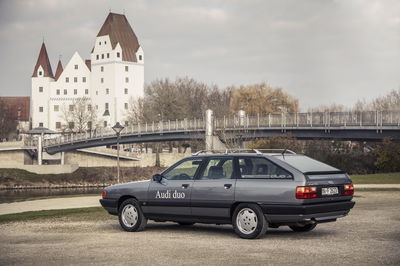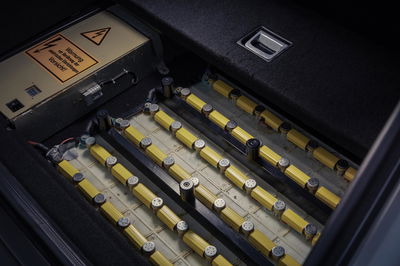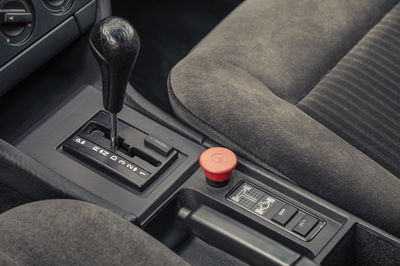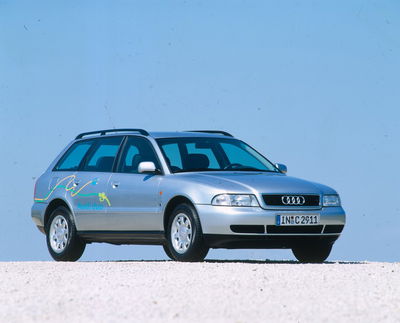That Time Audi Made A Hybrid Inline-Five 100 Avant

The idea of sticking hybrid powertrains in everything seems like a relatively recent phenomenon. For a while, buying ‘a hybrid’ invariably meant a Toyota Prius or something of that ilk, before a deluge of electrified options arrived. Before long, tightening emissions regulations will make electrification as good as the norm.
There are isolated cases of ‘normal’ fossil-fueled cars gaining electrical assistance, however. One example is the original Audi Duo, built way back in 1989. But despite being over 30 years old, it sounds - on paper at least - quite modern. An internal combustion engine (a 134bhp inline-five) drives the front wheels while a motor provides thrust at the rear, drawing power from a battery mounted under the boot floor. It even had a decent electric-only mileage of 24 miles.

The reality of operating it was a little more old-fashioned, however. There was no smooth switchover to electricity like in a modern hybrid - you had to come to a stop, put the car in neutral and press an ‘E’ button to swap power sources. And although the 180kg weight figure for the 8.4kWh nickel-cadmium battery pack (270kg for the whole system) seems thoroughly reasonable, the electric-only capability it gave you for those 24 miles was limited.
It powered a small motor - mounted on a quattro rear axle where the prop would normally live - which produced just 9kW and a more useful 81lb ft of torque. The top speed in E mode was just 31mph, and it took a leisurely eight seconds to reach 18mph.

By modern standers, the Duo is crude. But make no mistake - it was well ahead of its time in some areas. Despite there being no physical link between the axles, the two power sources could work together when the driver needed to pull away in slippery conditions, giving a pseudo all-wheel drive system. An unusual thing back then, but commonplace today.
The Duo also had a regenerative braking system which helped top up the battery pack. The best way to charge it when empty, though, was with a domestic plug socket - something which would take about eight to 10 hours. Audi also played around with a third charging method which to this day still hasn’t properly taken off - solar panels.
10 examples of the PHEV 100 were built for a pilot programme, and there was a ‘Duo II’ follow-up concept. Based on the C4 100, it switched the inline-five for a four-cylinder engine but gained a permanent quattro all-wheel drive system.

Six years on, the B5 A4 became the basis of Audi’s first production hybrid, which was the final car to adopt the ‘Duo’ name. Technology had advanced significantly in that time - the weight of the 28bhp motor had been trimmed down by half to 22kg and the unit could propel the car at speeds of up to 50mph.
Both it and a 90bhp 1.9-litre diesel engine powered the front axle. The rear-mounted lead-acid battery provided an electric-only range of around 30 miles and could be charged while on the move and via a domestic socket.

Audi had grand plans to shift 500 units a year, Automotive News reported at the time, but the A4 duo was expensive and extremely heavy, with the battery pack alone adding 320kg to the kerb weight. In the end, only around 90 units were sold.
Audi wouldn’t sell another PHEV until an electrified version of the Q5 arrived in 2011. All three versions of the duo were great tech showcases, but the timing just wasn’t quite right.
Now, better battery and motor technology plus worldwide efforts to reduce emissions mean we soon won’t be able to move for all the new hybrids. But just remember - they aren’t as new a thing as you might think.















Comments
I never even realised they made a model like this…
At least they didn’t destroy them without any valid reason and didn’t take intense care to make sure the surviving units wouldn’t be drivable again cough GM cough
Reminds me of Mitsubishi’s 2005 all electric EVO 9. Just like this, it was ahead of its time
I bet if you swapped the batteries for modern lithium ion cells, this could be a very impressive vehicle
They made a 100 diesel use 3.sth l/100km, but where did that technology go?
Elsbeth engine, another innovative tech, not around.
Face it, if they wanted to make an environmentally friendly car, they could